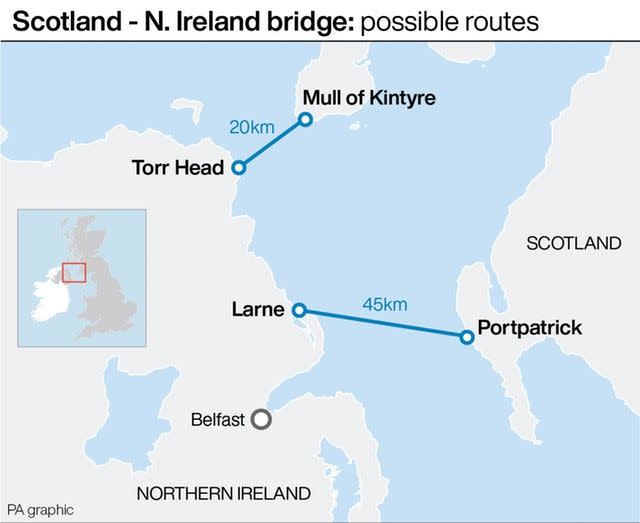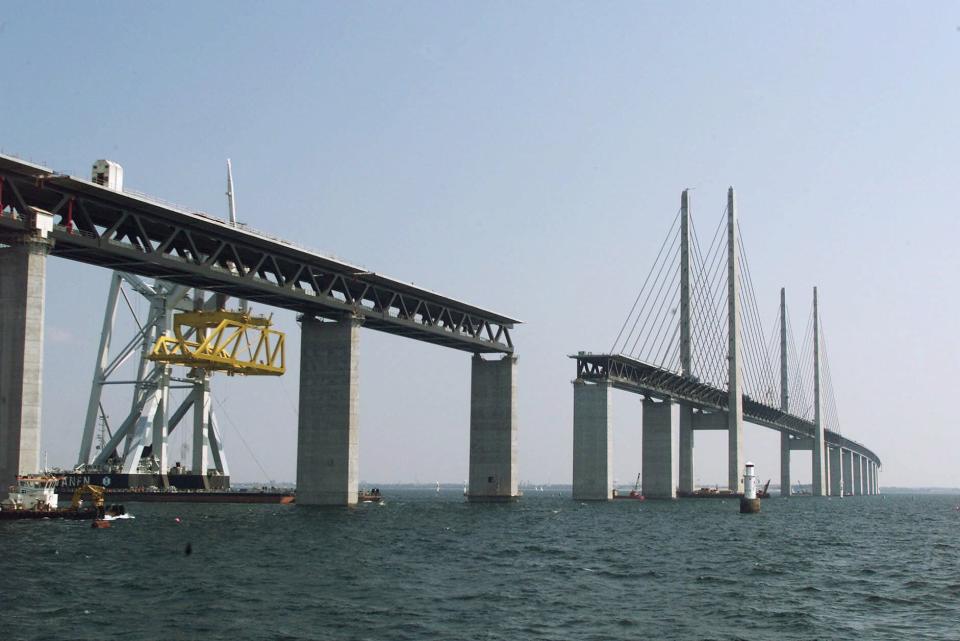'It's possible': What experts think of Boris Johnson's plans to build enormous bridge between Scotland and Northern Ireland

Boris Johnson's revived plans to build a £20 billion bridge between Scotland and Northern Ireland are “possible” and will lead to the “prosperity of the country”, according to experts.
The construction of a bridge/tunnel at the 20-mile gap between Northern Ireland and Scotland has been modelled on the Oresund Bridge, a bridge which runs for five miles across the Öresund strait between Sweden and Denmark.
Ministers are actively looking into the idea, according to Downing Street, with Boris Johnson describing the proposal as a "very interesting idea" before adding “watch this space”
Ireland's Leo Varadkar has said it was "worth examining", but insisted “the UK must pay for it, while Scotland’s Nicola Sturgeon said there were "more important priorities".
While some engineering experts branded the proposed plans a "huge risk" because of the potentially live munitions which were dumped in the area shortly after WWII.
Engineers are understood to have come up with the idea of a bridge-tunnel split as a way of dealing with Beaufort's Dyke, the UK's largest offshore dump site for munitions after the Second World War.

“The big unknown”
Alisdar Reisner, the Chief Executive for the Civil Engineering Contractors Association told Yahoo News that if the ambitious proposal were to go ahead it would not only be the "most significant bridge building projects the world has ever seen" but a dangerous endeavour because of what lies beneath the treacherous waters.
"What poses the biggest risk is the World War Two munitions, which is a big unknown, we don't know what condition they are in.
Beaufort's Dyke - a trench between Northern Ireland and Scotland within the Irish Channel- is the UK's largest offshore dump site for conventional and chemical munitions after the Second World War.
The Ministry of Defence says more than one million tons of weapons were jettisoned there, though some are known to have been dumped short of the Dyke in shallow coastal waters.
The area has been described as an "undersea ticking time bomb"
In a BBC report from 2004, Michael Fellows, a former Royal Navy diver, says the weapons, jettisoned in the Irish Sea, are "liable to go bang".
The government say that to deal with this issue they have come up with the idea of a bridge-tunnel split.

Under one version of Mr Johnson's plan, the bridge would run from the Scottish coast over the trench, before becoming a tunnel for the final stretch to Northern Ireland.
But Reisner feels that building in this territory would be extremely dangerous.
"There are tonnes and tonnes of munitions down there and we don't know what will happen if building commences there.
"If I were a betting man, I would say that it won't go ahead, the possible live munitions being the probable reason it won't happen because of the danger and risk, particularly during building.
"The sea they plan to build through is very deep, hundreds of metres deep.

"You've got to build islands to build the bridge on, so the islands would need to be the height of a skyscraper, in what is a pretty treacherous piece of water.
“From a structural point of view, it's a great idea”
However Wanda Lewis, an expert in structural engineering and professor at the University of Warwick says that “any project that would stimulate research into construction methods and possibly new materials is bound to be good and lead to the prosperity of the country.
“Structurally it is possible to build something like that, she told Yahoo News.
“The cost of building the foundations would be unpredictable but we are talking about a large timescale. The thing we need to talk about cost effectiveness.
“It will likely be a cable-fitted structure but the waters are very deep, with high winds.
When asked about the possibility of danger while building the bridge, she said: “I doubt that the ammunition is live but concrete is the ideal material to use to encase it.
“It’s been seventy years since they were dumped there, they would need to conduct an explosion risk assessment.
She pointed out that nuclear reactors are encased in concrete, although doing the same thing with Beaufort's Dyke is not environmentally friendly because it uses up a lot of Co2.
But she says from a “structural point of view, that it's a great idea.
“Anything that builds a bridge between nations is a good thing.”
“Anything is possible if you throw enough money at it”
Ian Firth, a fellow at the Institution of Civil Engineers, said there were a “huge number of technical challenges” in Boris Johnson’s proposal to link Scotland and Northern Ireland.
But he said “anything is possible if you throw enough money at it” – and that such a structure could be built within 15 years.
“My own feeling is that it ought to be possible because at the end of the day it’s about money – anything is possible if you throw enough money at it,” Mr Firth said.
“It has a huge number of technical challenges but that’s what us engineers are in the business of solving.
“I’m a great believer in the possible.”

